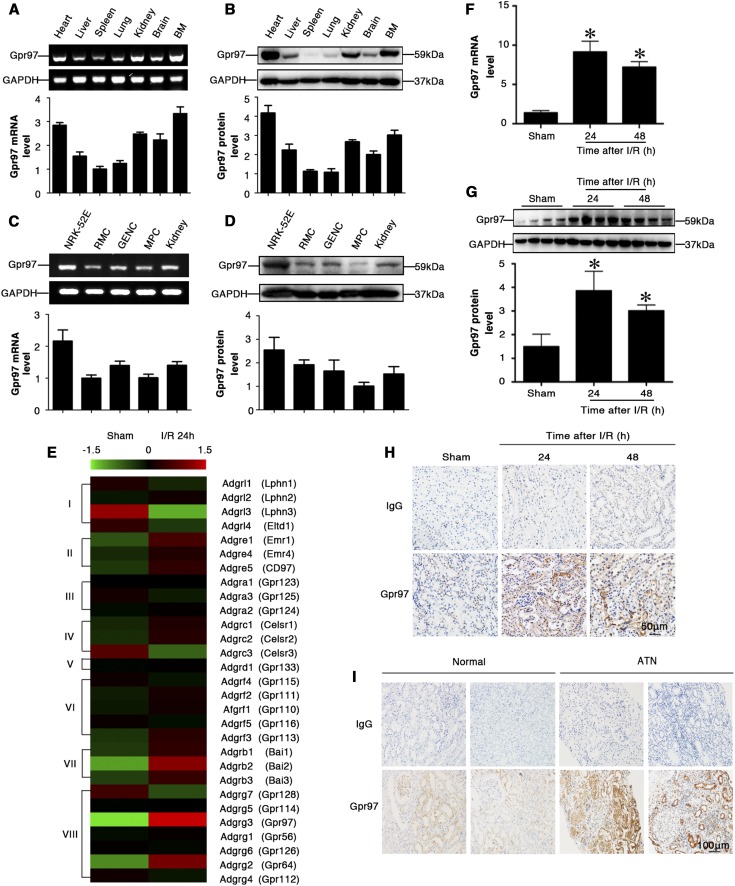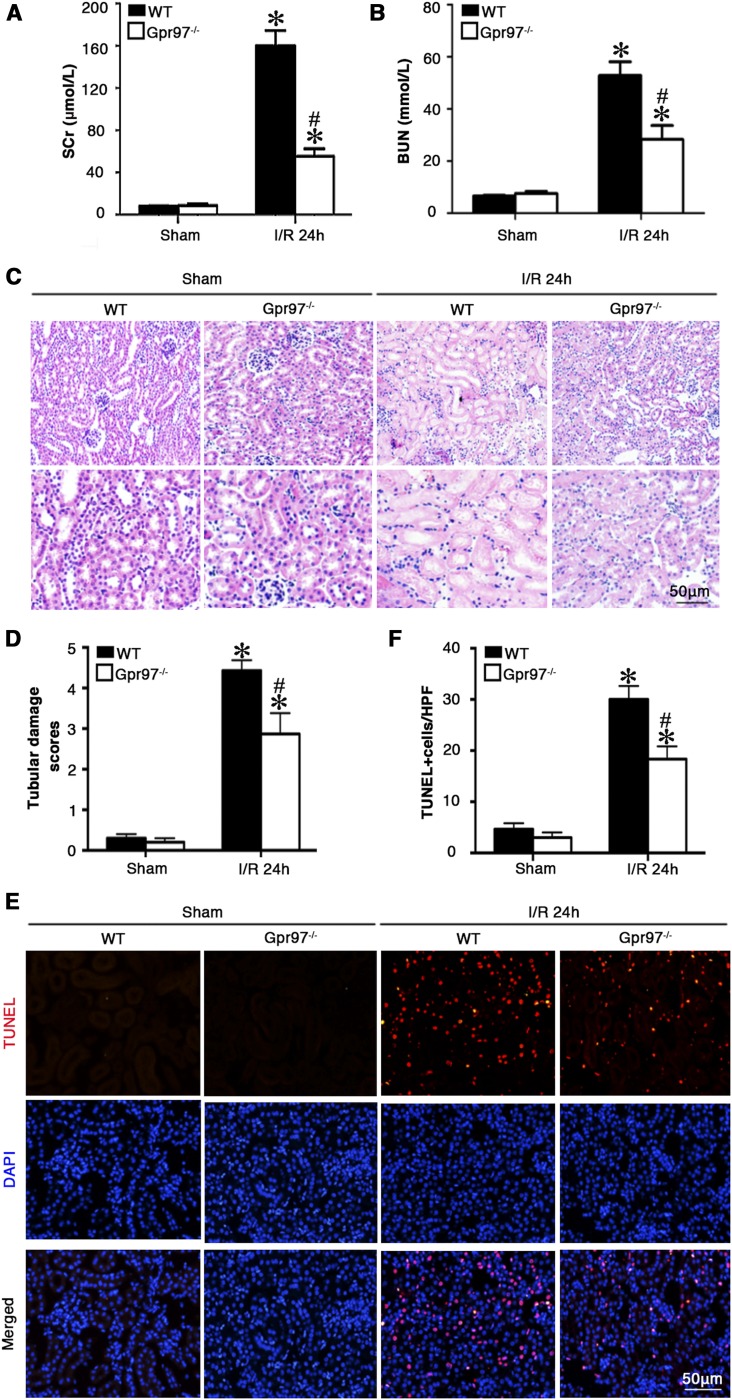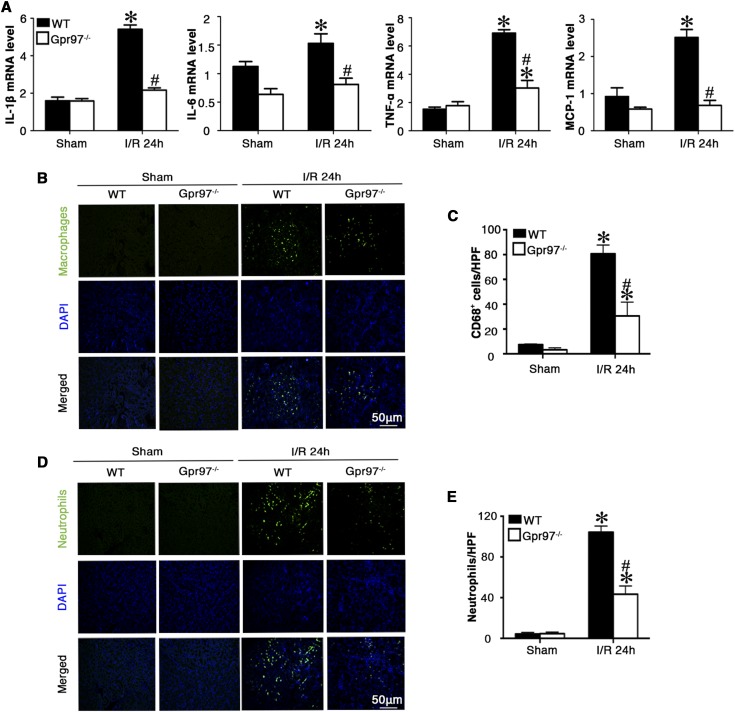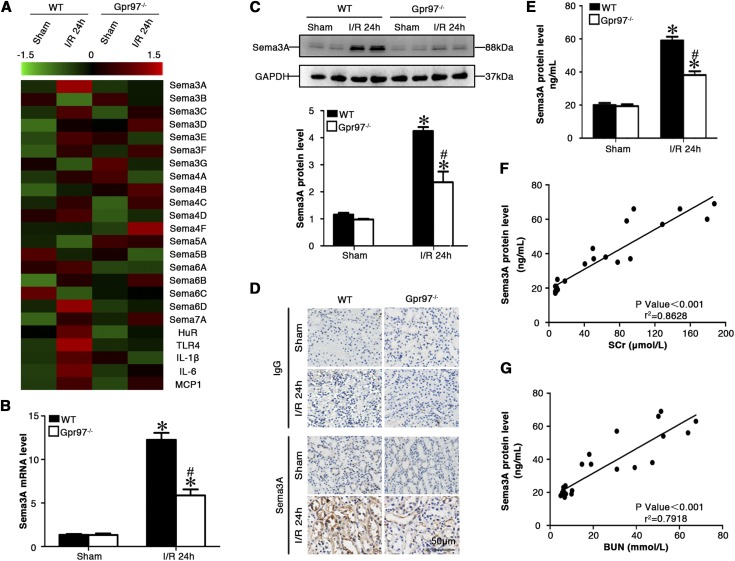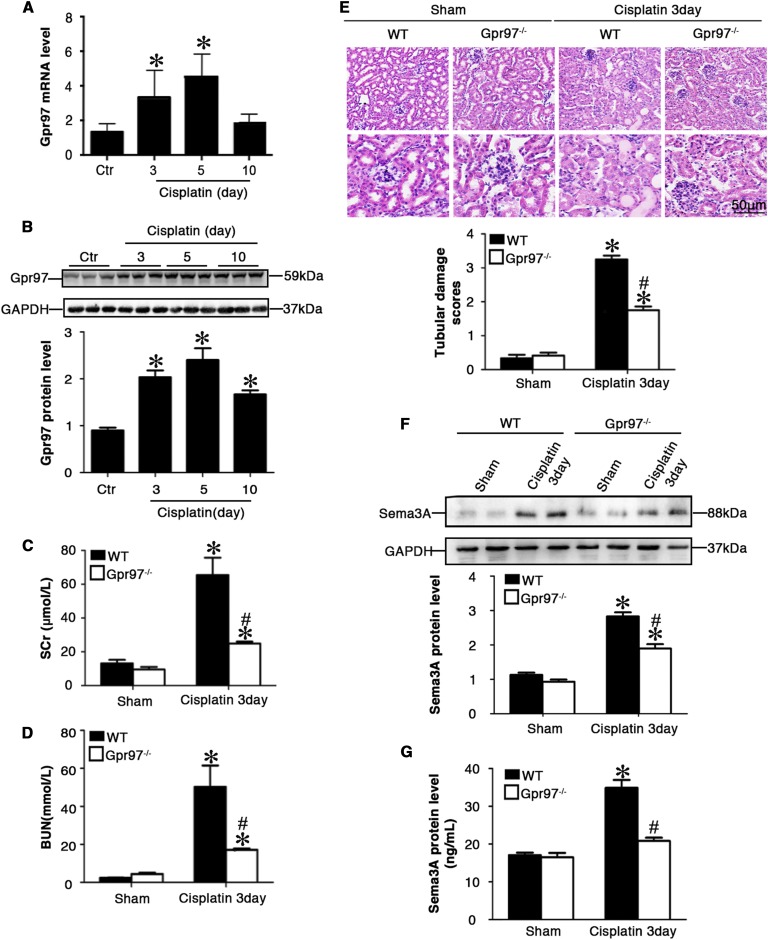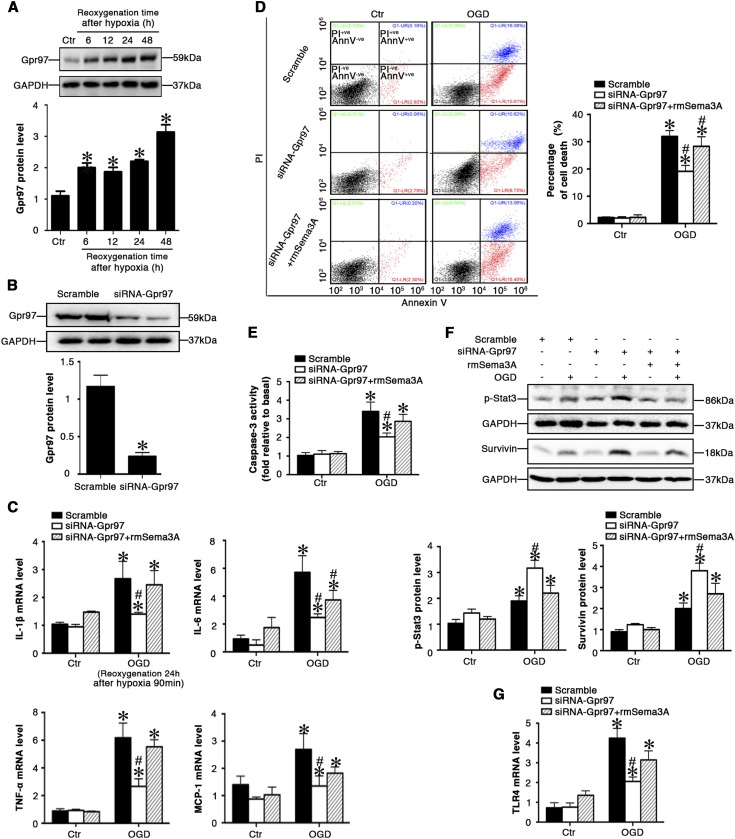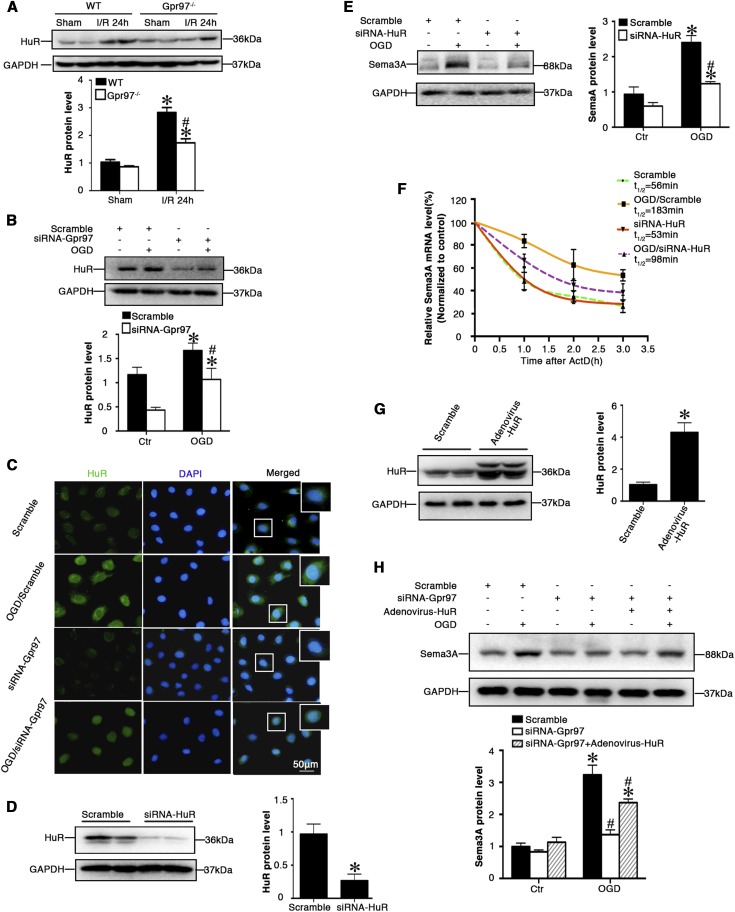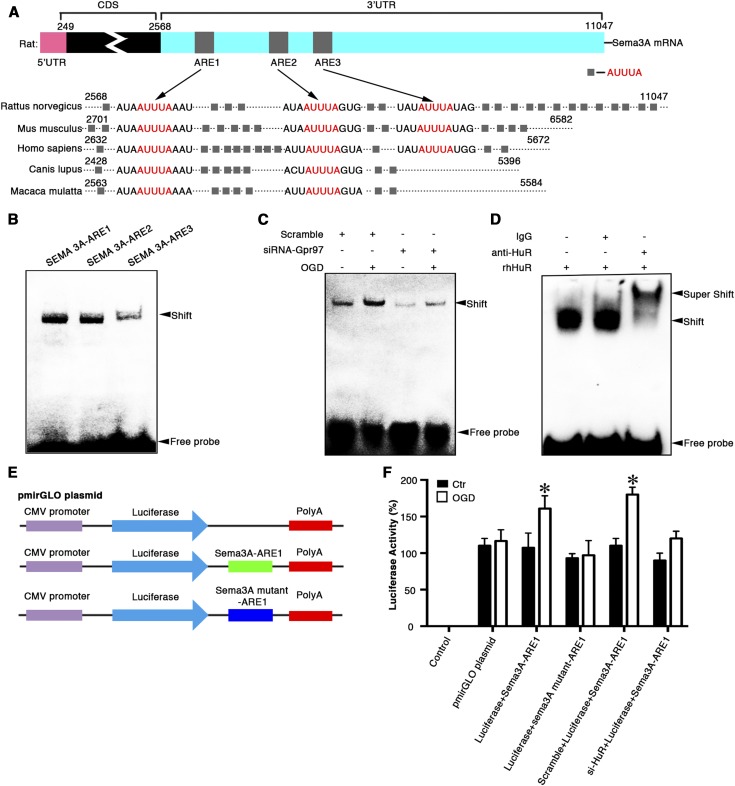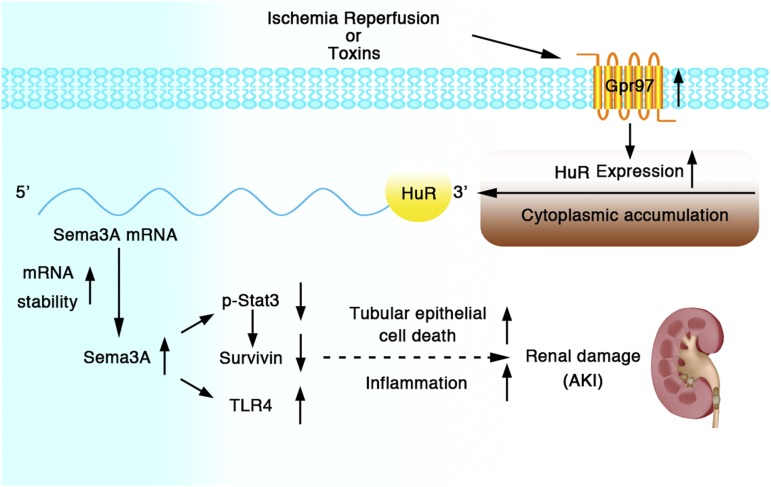Abstract
Background G protein-coupled receptors (GPCRs) participate in a variety of physiologic functions, and several GPCRs have critical physiologic and pathophysiologic roles in the regulation of renal function. We investigated the role of Gpr97, a newly identified member of the adhesion GPCR family, in AKI.
Methods AKI was induced by ischemia–reperfusion or cisplatin treatment in Gpr97-deficient mice. We assessed renal injury in these models and in patients with acute tubular necrosis by histologic examination, and we conducted microarray analysis and in vitro assays to determine the molecular mechanisms of Gpr97 function.
Results Gpr97 was upregulated in the kidneys from mice with AKI and patients with biopsy-proven acute tubular necrosis compared with healthy controls. In AKI models, Gpr97-deficient mice had significantly less renal injury and inflammation than wild-type mice. Gpr97 deficiency also attenuated the AKI-induced expression of semaphorin 3A (Sema3A), a potential early diagnostic biomarker of renal injury. In NRK-52E cells subjected to oxygen–glucose deprivation, siRNA-mediated knockdown of Gpr97 further increased the expression of survivin and phosphorylated STAT3 and reduced toll-like receptor 4 expression. Cotreatment with recombinant murine Sema3A protein counteracted these effects. Finally, additional in vivo and in vitro studies, including electrophoretic mobility shift assays and luciferase reporter assays, showed that Gpr97 deficiency attenuates ischemia–reperfusion-induced expression of the RNA-binding protein human antigen R, which post-transcriptionally regulates Sema3A expression.
Conclusions Gpr97 is an important mediator of AKI, and pharmacologic targeting of Gpr97-mediated Sema3A signaling at multiple levels may provide a novel approach for the treatment of AKI.
Keywords: acute renal failure, renal cell biology, ischemia-reperfusion, tubular epithelium, cisplatin nephrotoxicity, renal tubular epithelial cells
AKI is a serious clinical complication with high morbidity and mortality. Renal ischemia–reperfusion injury (IRI), nephrotoxic agents, and infection leading to sepsis are the major causes of AKI.1 Despite substantial progress in understanding the mechanisms contributing to the pathophysiology of AKI, there is no effective therapy available to treat or prevent AKI.2
The G protein-coupled receptor (GPCR) family is the largest membrane protein family; members participate in a variety of physiologic functions and are major targets of pharmaceutical drugs. Although GPCRs make up about 30% of targets for drugs on the market and are one of the largest families in clinical trials, the majority are still unexploited in therapies or trials. Therefore, identifying the key GPCRs involved in the pathogenesis of AKI and development of selective ligands targeting GPCRs may provide novel and effective treatment strategies for patients with AKI. The GPCR superfamily is grouped into five major families: glutamate, rhodopsin, adhesion, frizzled, and secretin. The adhesion GPCRs are a recently defined subfamily of GPCRs containing >30 members in the human genome, combining characteristics of adhesion molecules and seven transmembrane receptors.3 Adhesion GPCRs are receiving increased attention because many human diseases are linked to adhesion GPCRs mutations and genetic deletions produce intriguing phenotypes.4,5 Among them, Gpr97 is a newly identified adhesion GPCR that was originally identified in mouse intestinal lymphatic endothelium. It regulates migration of human lymphatic endothelial cells.6 Gpr97 is also expressed in murine pre-B cells and thymocytes.7 Although several studies8–9 have demonstrated that adhesion GPCRs are modulators of immune cell function, the role of Gpr97 on the regulation inflammatory responses continues to be controversial. Studies have shown that Gpr97 is involved in macrophage inflammation in high fat diet–induced obesity in mice.10 However, GPR97 is not required for the development of airway inflammation in ovalbumin-induced allergic asthma in mice,11 indicating that the regulation of inflammation via Gpr97 may vary depending on the pathophysiologic conditions. Considering that Gpr97 expression was significantly induced in the kidneys of mice with renal IRI in our preliminary studies and inflammatory responses elicited by ischemia are of importance in the functional deterioration of the kidney,12 this study was designed to elucidate the role of Gpr97 in AKI. Our results demonstrate for the first time that Gpr97 exacerbated AKI by regulation of semaphorin 3A (Sema3A), a potential early diagnostic biomarker of renal injury,13–15 thereby contributing to the inflammatory responses and tubular epithelial cell death. We further found that Gpr97 induced RNA-binding protein human antigen R (HuR) expression and activity, thereby increasing Sema3A mRNA stability.
Methods
An extended Material and Methods section can be found online in the Supplemental Material.
Animal Studies
Twelve-week-old male Gpr97-deficient (Gpr97−/−) mice (B6.129-Adgrg3tm1Smoc, 20–25 g body wt) were obtained from Shanghai Model Organisms Center (Shanghai, China). Induction of AKI induced by renal IRI or cisplatin was as previously described.16–18 All protocols were approved by Institutional Animal Care and Use Committee of Shandong University (permit no. 201402037) and conducted in accordance with the National Institutes of Health Guide for the Care and Use of Laboratory Animals.
Cell Culture and Treatments
Immortalized rat renal proximal tubule (NRK-52E) cells were cultured as described.19
Flow Cytometry
Cell apoptosis was determined by propidium iodide-annexin V staining as described.20
RNA Electrophoretic Mobility Shift Assay
Electrophoretic mobility shift assays (EMSAs) and supershift analysis with protein extracts were performed as described.21
Luciferase Reporter Assay and Transfection
Luciferase assays were performed for functional analysis of the 3′-UTR of Sema3A mRNA, using a luciferase reporter assay system (Promega, Madison, WI) as described.22
Data Availability
Microarray data sets have been deposited to the Gene Expression Omnibus database under accession code GSE108195.
Statistical Analyses
Data are expressed as means±SEM. The significance of the differences in mean values between and within multiple groups was examined by one-way ANOVA followed by Duncan multiple range tests. P<0.05 was considered statistically significant.
Results
Gpr97 Was Significantly Induced in the Kidneys of Mice with Renal IRI
Tissues examined were adult murine heart, liver, spleen, lung, kidney, brain, and bone marrow; Gpr97 was present in all these tissues with a relative high expression in the heart, kidney, and bone marrow by mRNA (Figure 1A) and Western blot (Figure 1B) analyses (Supplemental Tables 1 and 2). In the kidney, Gpr97 was expressed in various types of renal parenchymal cells, including rat proximal tubule epithelial cells (NRK-52E), rat glomerular mesangial cells, rat glomerular endothelial cells, and murine podocytes (Figure 1, C and D). Using Agilent Whole Mouse Genome Oligo Microarray for global gene expression analysis, we found the upregulation of Gpr97 in the kidneys of mice with renal IRI (Figure 1E), which was further confirmed by mRNA (Figure 1F), Western blot (Figure 1G), and immunohistochemical (Figure 1H) analyses. To define the tubular segment-specificity of Gpr97 expression in the kidney, we used double immunostaining for Gpr97 (green) and various tubular markers (red) in the kidney. As shown in Supplemental Figure 1, Gpr97 was mainly expressed and induced in proximal tubules and distal tubules after renal IRI. Moreover, compared with kidney tissues obtained from patients who underwent tumor nephrectomies without other renal disease, Gpr97 was also upregulated in the kidneys of patients with biopsy-proven acute tubular necrosis, which presents with AKI and is one of the most common causes of AKI (Figure 1I).
Figure 1.
Gpr97 was significantly induced in the kidneys of mice with renal IRI. (A) RT-PCR analysis of Gpr97 mRNA levels in selected murine tissues, including heart, liver, spleen, lung, kidney, brain, and bone marrow (BM). (B) Western blot analysis of the relative protein levels of Gpr97 in selected murine tissues. (C) RT-PCR analysis of Gpr97 mRNA levels in renal cells including rat proximal tubule epithelial cells (NRK-52E), rat glomerular mesangial cells, rat glomerular endothelial cells, and murine podocytes. (D) Western blot analysis of the relative protein levels of Gpr97 in renal cells. (E) Representative heatmap of gene expression levels of adhesion GPCRs in the kidneys of mice with IRI by multiplex qRT-PCR array. (F) Relative mRNA levels of Gpr97 in the kidneys of mice with renal IRI. (G) Representative Western blot gel documents and summarized data showing the protein levels of Gpr97 in the kidneys of mice with renal IRI. (H) Representative photomicrographs of 3,3'-diaminobenzidine (DAB) immunohistochemical staining of Gpr97 in the kidneys of mice with IRI. (I) Representative photomicrographs of 3,3'-diaminobenzidine (DAB) immunohistochemical staining of Gpr97 in the kidneys of patients with biopsy-proven acute tubular necrosis (ATN). Normal kidney tissues were obtained from the healthy kidney poles of individuals who underwent tumor nephrectomies without renal disease. *P<0.05 versus sham-operated wild-type mice (n=8).
Gpr97 Deficiency Ameliorated Renal IRI in Mice
Gpr97−/− mice were phenotypically normal and had no appreciable defects in renal morphology and function. However, Gpr97 deficiency significantly ameliorated renal IRI in mice, as evidenced by the reduction of serum creatinine (Figure 2A) and BUN (Figure 2B), improved morphologic injury (Figure 2, C and D), and reduced cell death as demonstrated by terminal deoxynucleotidyl transferase–mediated digoxigenin-deoxyuridine nick-end labeling staining (Figure 2, E and F).
Figure 2.
Gpr97 deficiency ameliorated renal IRI in mice. (A) Serum creatinine (SCr) concentration in different groups of mice. (B) BUN levels in different groups of mice. (C) Representative micrographs showing the morphology by hematoxylin and eosin (H&E) staining of the kidney from different groups of mice. (D) Quantitative assessment of tubular damage. (E) In situ terminal deoxynucleotidyl transferase–mediated UTP nick-end labeling (TUNEL) assays were performed to assess renal cell death. Nuclei were revealed using 4’,6-diamidino-2-phenylindole (DAPI) staining. (F) Quantitative assessment of the number of cell death (numbers per high-power field [HPF]). *P<0.05 versus sham-operated wild-type mice (n=8); #P<0.05 versus ischemic wild-type mice at the same experimental conditions.
Gpr97 Deficiency Reduced Inflammatory Responses in the Kidney after Renal IRI in Mice
Gpr97 deficiency reduced inflammatory responses by decreasing the levels of proinflammatory mediators (Figure 3A), and macrophage (Figure 3, B and C) and neutrophil (Figure 3, D and E) infiltration in the kidneys of mice with IRI.
Figure 3.
Gpr97 deficiency reduced inflammatory responses in the kidney after renal IRI in mice. (A) The mRNA levels of proinflammatory mediators including IL-1β, IL-6, TNF-α, and monocyte chemoattractant protein-1 (MCP-1) in the kidney from different groups of mice. (B) Representative sections of kidney stained for macrophages from different groups of mice. (C) Data analysis of macrophage infiltrates in the kidney (numbers per high-power field [HPF]) from different groups of mice. (D) Representative sections of kidney stained for neutrophils from different groups of mice. (E) Data analysis of neutrophil infiltrates in the kidney (numbers per HPF) from different groups of mice. *P<0.05 versus sham-operated wild-type mice; #P<0.05 versus ischemic wild-type mice at the same experimental conditions (n=8).
Gpr97 Mediated Sema3A Expression
Using microarray analysis, we found that IRI-induced Sema3A expression was significantly abolished by Gpr97 deficiency in mice (Figure 4A), which was further confirmed by mRNA (Figure 4B), Western blot (Figure 4C), and immunohistochemical (Figure 4D) analyses. Moreover, the serum levels of Sema3A were also decreased in Gpr97−/− mice with renal IRI (Figure 4E), which were positively correlated with serum creatinine (Figure 4F) and BUN (Figure 4G), individually.
Figure 4.
Gpr97 mediated Sema3A expression. (A) Representative heatmap of gene expression levels in the kidneys of mice with IRI by multiplex qRT-PCR array. (B) Summarized data showing the mRNA levels of Sema3A in the kidneys of mice with renal IRI. (C) Representative Western blot gel documents and summarized data showing the protein levels of Sema3A in the kidneys of mice with renal IRI. (D) Representative photomicrographs of Sema3A 3,3'-diaminobenzidine (DAB) immunohistochemical staining in the kidneys of mice with renal IRI. (E) Summarized data showing the serum levels of Sema3A in mice with renal IRI. (F) Positive correlation between the serum levels of Sema3A and serum creatinine (SCr) in all mice. (G) Positive correlation between the serum levels of Sema3A and BUN in all mice. *P<0.05 versus sham-operated wild-type mice; #P<0.05 versus ischemic wild-type mice at the same experimental conditions (n=8).
Gpr97 Deficiency Also Protected against AKI Induced by Cisplatin
To further confirm the implications of Gpr97 signaling in the kidney, we investigated whether Gpr97 also plays a detrimental role in mice with AKI induced by cisplatin. It was found that Gpr97 expression was also increased in the kidneys of mice after cisplatin injection (Figure 5, A and B). Gpr97 deficiency ameliorated renal dysfunction (Figure 5, C and D), histologic lesions (Figure 5E), and reduced the levels of proinflammatory mediators and macrophage and neutrophil infiltration (Supplemental Figure 2). Gpr97 deficiency reduced the levels of Sema3A both in the kidney (Figure 5F) and in the serum (Figure 5G) from mice with cisplatin treatment. Together, these results indicate that Gpr97-mediated Sema3A signaling may be a common response in the kidney after AKI.
Figure 5.
Gpr97 deficiency protected against AKI induced by cisplatin. (A) Relative mRNA levels of Gpr97 in the kidney from different groups of mice. (B) Representative Western blot gel documents and summarized data showing the levels of Gpr97 in the kidney from different groups of mice. (C) Serum creatinine (SCr) concentration in different groups of mice. (D) BUN levels in different groups of mice. (E) Representative micrographs showing the morphology by hematoxylin and eosin (H&E) stainingand and quantitative assessment of tubular damage from different groups of mice. (F) Summarized data showing the expression levels of Sema3A in the kidney from different groups of mice. (G) Summarized data showing the serum levels of Sema3A in different groups of mice. *P<0.05 versus sham-operated wild-type mice; #P<0.05 versus wild-type mice with cisplatin treatment (n=8).
Gpr97 Contributed to Hypoxia-Induced Production of Proinflammatory Mediators and Cell Death in Rat Proximal Tubular Epithelial (NRK-52E) Cells via Sema3A
In vitro, we used several approaches to produce hypoxic conditions: oxygen–glucose deprivation (OGD, Figure 6A) via chemical anoxia/recovery induced by incubating NRK-52E cells in glucose-free medium with antimycin A/2-deoxyglucose for ATP depletion (60 minutes, anoxia), and then in glucose-replete complete growth medium (recovery) or cobalt chloride treatment (Supplemental Figure 3). All manipulations significantly induced Gpr97 expression. Gene silencing of Gpr97 (Figure 6B) inhibited hypoxia-induced levels of proinflammatory mediators (Figure 6C). Using flow cytometric analysis, we found that the overall percentage of cell death and the number of apoptotic and necrotic cells was significantly decreased by gene silencing of Gpr97 in NRK-52E cells under hypoxia conditions (Figure 6D). We also found that gene silencing of Gpr97 reduced hypoxia-induced caspase-3 activity, further confirming that Gpr97 mediates cell apoptosis (Figure 6E). Similar results were also obtained from gene silencing of Sema3A (Supplemental Figure 4). At the molecular level, Gpr97 deficiency inhibited hypoxia-induced Sema3A expression. Considering that STAT3 phosphorylation and subsequent upregulation of survivin in renal proximal tubule epithelial cells protect against AKI and aid the functional and structural recovery of the kidney from AKI,23 and STAT3 phosphorylation is downregulated by Sema3A,24,25 we further investigated whether Gpr97 regulates the STAT3-survivin signaling pathway by Sema3A. Compared with controls, STAT3 phosphorylation and survivin had a compensatory increase in NRK-52E cells under OGD conditions, which was further induced by Gpr97 deficiency (Figure 6F). In addition, gene silencing of Gpr97 reduced toll-like receptor 4 (TLR4) mRNA levels, a major target of Sema3A for the regulation of inflammatory responses (Figure 6G). Importantly, all these effects of Gpr97 knockdown could be counteracted by recombinant mouse Sema3A proteins (Fc tagged, 100 ng/ml) in NRK-52E cells. The upregulation of Gpr97 was also confirmed in NRK-52E cells with cisplatin treatment (Supplemental Figure 5).
Figure 6.
Gpr97 contributed to hypoxia-induced production of proinflammatory mediators and cell death in NRK-52E cells via Sema3A. (A) Representative Western blot gel documents and summarized data showing the protein levels of Gpr97 in NRK-52E cells under OGD conditions (cultured in a hypoxic environment for 90 minutes at 0.1% O2, followed by reoxygenation at different time points [6, 12, 24, or 48 hours]). (B) Representative Western blot gel documents and summarized data showing the gene silencing efficiency of Gpr97 by siRNA-Gpr97 transfection. (C) The effect of Gpr97 on the mRNA levels of proinflammatory mediators in NRK-52E cells under OGD conditions (cultured in a hypoxic environment for 90 minutes at 0.1% O2, followed by reoxygenation at 24 hours). (D) Summarized data showing the overall percentage of cell death, including the amount of apoptotic and necrotic cells determined by flow cytometric analysis in NRK-52E cells with different treatments. (E) Summarized data showing the caspase-3 activity in NRK-52E cells with different treatments. (F) Representative Western blot gel documents and summarized data showing the effect of Gpr97 on the levels of STAT3 phosphorylation and survivin in NRK-52E cells with different treatments. (G) Summarized data showing the mRNA levels of TLR4 in NRK-52E cells with different treatments. *P<0.05 versus control; #P<0.05 versus vehicle of NRK-52E cells under OGD conditions (n=6).
Gpr97 Induced Sema3A Expression by Mediating HuR Expression and Activation
As shown in Figure 7A, IRI-induced HuR expression in the kidney was significantly attenuated in Gpr97−/− mice. In vitro, we also found that gene silencing of Gpr97 inhibited hypoxia-induced HuR expression (Figure 7B). A marked accumulation of cytoplasmic HuR was also observed in NRK-52E cells under OGD treatment by immunofluorescence analysis, which was inhibited by Gpr97 knockdown (Figure 7C). Moreover, gene silencing of HuR (Figure 7D) attenuated hypoxia-induced Sema3A expression, even at the basal level in NRK-52E cells (Figure 7E). To determine whether HuR-mediated Sema3A expression results from the regulation of mRNA stability, actinomycin D, a transcription inhibitor, was applied to block Sema3A transcription 12 hours after OGD treatment. It was found that siRNA-HuR transfected NRK-52E cells had a shorter t1/2 of Sema3A mRNA under hypoxia conditions (Figure 7F), indicating that HuR contributes to the regulation of Sema3A mRNA stability. Consistently, overexpression of HuR by recombinant HuR-expressing adenoviral plasmid transfection (Figure 7G) counteracted Gpr97 deficiency-reduced Sema3A expression (Figure 7H).
Figure 7.
Gpr97 induced Sema3A expression by mediating HuR expression and activation. (A) Representative Western blot gel documents and summarized data showing the protein levels of HuR in the kidneys of mice with renal IRI. *P<0.05 versus sham-operated wild-type mice; #P<0.05 versus ischemic wild-type mice (n=8). (B) Representative Western blot gel documents and summarized data showing the protein levels of HuR in NRK-52E cells under OGD conditions. *P<0.05 versus control; #P<0.05 versus vehicle of NRK-52E cells under OGD conditions (n=6). (C) Representative microscopic images for immunofluorescence staining showing the distribution of HuR in NRK-52E cells under OGD conditions. (D) Representative Western blot gel documents and summarized data showing the gene silencing efficiency of HuR by siRNA-HuR transfection. (E) Representative Western blot gel documents and summarized data showing the effect of HuR on the Sema3A protein in NRK-52E cells under OGD conditions. *P<0.05 versus control; #P<0.05 versus vehicle of NRK-52E cells under OGD conditions (n=6). (F) Summarized data showing the effect of HuR on the regulation of Sema3A mRNA stability. After NRK-52E cells were transfected with siRNA-HuR or scramble, the cells were treated without (control) or with OGD conditions for 12 hours before addition of actinomycin D (ActD). (G) Representative Western blot gel documents and summarized data showing the overexpression of HuR by adenovirus transfection (ORF of ELAVL1 [HuR] in adenoviral vector pAd with C-terminal Flag and His tag; Adenovirus-HuR) in NRK-52E cells. *P<0.05 versus control (n=6). (H) Representative Western blot gel documents and summarized data showing that HuR overexpression counteracted Gpr97 deficiency-reduced Sema3A expression. *P<0.05 versus control; #P<0.05 versus vehicle of NRK-52E cells under OGD conditions (n=6).
HuR Interacted with the 3′-UTR of Sema3A mRNA and Was Involved in Hypoxia-Mediated Sema3A mRNA Stability
Sequence alignment of 3′-UTR of Sema3A from various species showed that three AU-rich elements (AREs) with canonical AUUUA sequences that may serve as determinants for Sema3A mRNA stability are highly conserved (Figure 8A). Thus, RNA-EMSA was performed to explore whether HuR regulates Sema3A expression via directly binding to its transcript. Different RNA oligonucleotides each encompassed conserved putative AREs from the 3′-UTR of rat Sema3A mRNA, denominated as Sema3A-ARE1, Sema3A-ARE2, and Sema3A-ARE3, respectively. A complex was formed when Sema3A-AREs were applied for the binding reaction in NRK-52E cells (Figure 8B), as well as in the cytoplasmic extracts from the mouse kidney and human proximal tubular epithelial (HK-2) cells (Supplemental Figure 6). Using the SEMA3A-ARE1 probe, we found that the binding ability was strongly increased in extracts from NRE-52E cells under OGD conditions, which was abolished by Gpr97 deficiency (Figure 8C). In addition, the probe Sema3A-ARE1-HuR complex was supershifted by anti-HuR antibody. Recombinant human HuR protein was used as a positive control to confirm the interaction between HuR and Sema3A-ARE1 (Figure 8D). To further confirm that the 3′-UTR promotes Sema3A mRNA expression, various plasmids containing the 3′-UTR and luciferase reporter gene were transfected into NRK-52E cells individually (Figure 8E). In the absence of the Sema3A-ARE1 sequence or with a mutation in ARE1, hypoxia had no effect on the enzyme activity (Figure 8F). However, hypoxia significantly induced enzyme activity in the pmirGLO-Luciferase-Sema3A-ARE1 plasmid-transfected group, which was attenuated by siRNA-HuR. Similar results were also found the interaction between HuR and Sema3A-ARE2 or Sema3A-ARE3 (data not shown).
Figure 8.
HuR interacted with the 3′-UTR of Sema3A mRNA and was involved in hypoxia-induced Sema3A mRNA stability. (A) Sequence homology analysis of 3′UTR of Sema3A mRNA among different species. In rats, 22 canonical ARE sites were labeled. (B) The cytoplasmic extracts from NRK-52E cells were prepared for RNA-EMSA analysis. Complexes were formed when Sema3A-ARE1, Sema3A-ARE2, and Sema3A-ARE3 were applied for the binding reaction. (C) RNA-EMSA assay showing that the binding ability was strongly increased in extracts from NRE-52E cells under OGD conditions, which was abolished by gene silencing of Gpr97 using Sema3A-ARE1. (D) Recombinant human HuR proteins (rhHuR) were used as positive controls to confirm the interaction between HuR and Sema3A-ARE1 by RNA-EMSA. (E) A schematic representation of the construction of various plasmids containing luciferase and 3′-UTR of Sema3A-ARE1 mRNA. (F) The luciferase activity was quantified by in NRE-52E cells transfected with different plasmids. *P<0.05 versus control (n=6).
Discussion
GPCRs such as dopamine-1 receptor, angiotensin II receptors, and endothelin-1 receptors are widely expressed in the kidney,26,27 and are known to play vital roles in the regulation of renal function, with dysregulation of GPCR signaling closely associated with kidney disease and systemic disorders, but the role of Gpr97 in the kidney remains unknown. In this study, using two separate murine AKI models of IRI and cisplatin-induced AKI, we found that Gpr97 deficiency markedly ameliorated renal dysfunction, histologic lesions, and inflammatory responses in mice. Importantly, we confirmed that the expression of Gpr97 was also induced in the kidneys of patients with biopsy-proven acute tubular necrosis in the retrospective cohort study. In addition, we also observed the upregulation of Gpr97 in renal biopsies from patients with CKD, including FSGS, minimal change disease, and membranous GN (Supplemental Figure 7), suggesting that Gpr97 may be a common predictor for renal injury.
Regarding the regulatory mechanism of Gpr97 expression in the kidney under hypoxia conditions, we speculate that Gpr97 upregulation may be mediated by transcription factor hypoxia-inducible factor 1α (HIF-1α). It is known that HIF-1α is induced in mammalian cells in response to hypoxia conditions or hypoxia-mimetic agents such as cobalt chloride. Emerging evidence has confirmed that some GPCRs are HIF-1α target genes. HIF-1α is a mediator of heregulin-induced CXCR4 upregulation in breast cancer cells.28 HIF-1α is also required for both the transactivation of the Gpr30 promoter reporter gene as well as for the upregulation of Gpr30 expression upon hypoxia.29 Therefore, considering that hypoxia induces Gpr97 expression, Gpr97 may be induced by HIF-1α. On the other hand, certain ligand-activated GPCRs can also induce HIF-1α expression. The recruitment of transcription factors to the promoter sequence of HIF-1α as well as the stabilization of HIF-1α protein levels may occur upon activation of GPCRs by endothelin-1 or β-adrenoceptor agonists.30–32 Therefore, further study will be needed to determine whether HIF-1α induces Gpr97 expression and whether a feedforward mechanism exists between Gpr97 and HIF-1α–mediated signaling.
Although the endogenous ligands of Gpr97 are unknown, Gpr97 is an orphan adhesion GPCR with high homology to the better characterized Gpr56. Like Gpr56, Gpr97 possesses both an exceptionally long extracellular region, characteristic of cell adhesion proteins, and an intracellular region reminiscent of other GPCRs. Recently, some specific ligands of Gpr56 have been identified. Collagen III33 and tissue transglutaminase 234 interact with the N-terminal extended extracellular domain fragment of Gpr56. In addition to these ligands, which presumably interact with Gpr56 in trans, some cis-acting binding partners have also been found, such as tetraspanins CD9 and CD81.35 Considering the similarity between Gpr56 and Gpr97, it is possible that Gpr97 may share ligands with Gpr56, and the cellular functions of Gpr97 may be mediated by interacting with specific protein ligands on the cell surface and/or in the extracellular matrix.
In this study, a positive correlation between the levels of Gpr97 and Sema3A was observed in the kidney. The semaphorin family members are divided into eight classes on the basis of their structural features and distributions among different phyla. Classes 1 and 2 contain invertebrate semaphorins whereas classes 3–7 contain the 22 vertebrate semaphorins. Class 8 contains viral semaphorins. The semaphorins not only play essential roles in the development and function of many different physiologic systems, but also contribute to the pathology of various diseases. In this study, we observed the changes in semaphorins by microarray analysis in the kidneys of ischemic mice. Among them, Sema3A was significantly induced, which has been demonstrated to play a vital role on the regulation of renal function. Sema3A is of importance in patterning the developing kidney by modulating ureteric bud branching, vascularization, podocyte differentiation, and maintaining the integrity of the glomerular filtration barrier.36–38 Moreover, dysregulation of Sema3A is known to exacerbate renal injury in adult kidney models of both chronic and acute kidney disease. Sema3A gain-of-function in podocytes leads to proteinuric glomerular disease in mice and excess Sema3A causes foot process effacement, glomerular basement lamination, and endothelial damage.39 In AKI, genetic inactivation of Sema3A protected mice from IRI-induced AKI, improved tissue histology, reduced neutrophil infiltration, and inhibited epithelial cell apoptosis.15 Recent studies have also demonstrated that Sema3A is an early, predictive biomarker in experimental and pediatric AKI.13 In this study, we found that Gpr97 deficiency markedly inhibited IRI-induced Sema3A expression both in the kidney and in the serum. We further found that Gpr97 induced inflammatory responses and tubular epithelial cell death through mediation of Sema3A. Although we did not attempt to explore the molecular mechanisms by which Gpr97-mediated Sema3A signaling contributes to AKI in detail, we also detected the known downstream targets of Sema3A. It was found that Gpr97 mediated TLR4 expression by Sema3A, which was consistent with the previous studies showing that Sema3A induced TLR4 signaling, which could foster nuclear NF-κB activation and inflammation.15,40 In addition, Gpr97 reduced STAT3 phosphorylation and subsequent downregulated survivin expression in renal proximal tubule epithelial cells, thereby preventing the functional and structural recovery of the kidney from AKI. Taken together, these data clearly suggest that Sema3A signaling is one of the critical signal transduction pathways that link Gpr97 to AKI.
Finally, we provide the first direct evidence that HuR acts as a key post-transcriptional regulator of Gpr97 mediated-Sema3A expression in AKI. HuR is a member of the embryonic lethal abnormal vision (ELAV)-like family of RNA-binding proteins, which regulates mRNA cargos that typically contain AREs in the 3′-UTR.41 Although HuR is normally localized to the nucleus, the stability of the ARE-containing mRNAs in response to stress conditions correlates with the translocation of HuR to the cytoplasm. HuR has been demonstrated to be involved in the regulation of renal homeostasis and the adaptive responses contributing to the pathogenesis of various renal disease, such as ischemia, fibrosis, and diabetic nephropathy.42–44 Although Sema3A mRNA from different species bear long 3′-UTR with various AREs, the mechanisms involved in the post-transcriptional regulation of Sema3A are poorly understood. Using RNA-EMSA assay, we demonstrated that Sema3A mRNA is a target of the mRNA-stabilizing protein HuR. It should be noted that although our studies indicate a causal link between Gpr97 and HuR, we did not focus on the regulatory mechanisms of Gpr97 on HuR, and recent studies have shown that inactivation of Gpr97 would lead to an increase in cAMP levels.45 cAMP is a negative regulator of HuR,46 therefore it is possible that Gpr97 regulates the expression of HuR via cAMP-mediated signaling. Further studies are needed to confirm these findings in the kidney.
In summary, we demonstrate that Gpr97 exacerbates AKI by regulation of the Sema3A signaling pathways, and further identify that Gpr97-mediated HuR acts as a key post-transcriptional regulator of Sema3A expression (Figure 9). Our results suggest that Gpr97 is an important mediator of AKI, and that pharmacologic targeting of Gpr97-mediated Sema3A signaling pathways at multiple levels may provide a novel approach for the treatment of patients with AKI.
Figure 9.
Schematic representation showing that Gpr97 exacerbates AKI via mediating Sema3A signaling. In this model, Gpr97 contributed to the development of postischemic renal inflammation and promoted tubular epithelial cell death, which was associated with the regulation of Sema3A. Gpr97-induced Sema3A expression and mRNA stability were regulated by HuR.
Disclosures
None.
Supplementary Material
Acknowledgments
F.Y. designed the study; W.F., Z.W., Q.L., X.W., and Y.S. carried out experiments; C.M., J.S., and N.L. analyzed the data; W.F., W.T., and Y.Z. made the figures; F.Y. and W.F. drafted and revised the manuscript; all authors approved the final version of the manuscript.
This study was supported by the National Science Fund for Distinguished Young Scholars (grant 81525005 to F.Y.), The National Nature Science Foundation of China (grants 91642204 and 81470958 to F.Y., 81600570 to X.W., 81670629 to W.T., 81770726 to Y.Z., and 81400730 to Z.W.).
Footnotes
Published online ahead of print. Publication date available at www.jasn.org.
This article contains supplemental material online at http://jasn.asnjournals.org/lookup/suppl/doi:10.1681/ASN.2017080932/-/DCSupplemental.
References
- 1.Jang HR, Rabb H: Immune cells in experimental acute kidney injury. Nat Rev Nephrol 11: 88–101, 2015 [DOI] [PubMed] [Google Scholar]
- 2.Rewa O, Bagshaw SM: Acute kidney injury-epidemiology, outcomes and economics. Nat Rev Nephrol 10: 193–207, 2014 [DOI] [PubMed] [Google Scholar]
- 3.Paavola KJ, Sidik H, Zuchero JB, Eckart M, Talbot WS: Type IV collagen is an activating ligand for the adhesion G protein-coupled receptor GPR126. Sci Signal 7: ra76, 2014 [DOI] [PMC free article] [PubMed] [Google Scholar]
- 4.Hamann J, Aust G, Araç D, Engel FB, Formstone C, Fredriksson R, et al.: International Union of Basic and Clinical Pharmacology. XCIV. Adhesion G protein-coupled receptors. Pharmacol Rev 67: 338–367, 2015 [DOI] [PMC free article] [PubMed] [Google Scholar]
- 5.Kishore A, Hall RA: Versatile signaling activity of adhesion GPCRs. Handb Exp Pharmacol 234: 127–146, 2016 [DOI] [PubMed] [Google Scholar]
- 6.Valtcheva N, Primorac A, Jurisic G, Hollmén M, Detmar M: The orphan adhesion G protein-coupled receptor GPR97 regulates migration of lymphatic endothelial cells via the small GTPases RhoA and Cdc42. J Biol Chem 288: 35736–35748, 2013 [DOI] [PMC free article] [PubMed] [Google Scholar]
- 7.Sleckman BP, Khan WN, Xu W, Bassing CH, Malynn BA, Copeland NG, et al.: Cloning and functional characterization of the early-lymphocyte-specific Pb99 gene. Mol Cell Biol 20: 4405–4410, 2000 [DOI] [PMC free article] [PubMed] [Google Scholar]
- 8.Zugasti O, Bose N, Squiban B, Belougne J, Kurz CL, Schroeder FC, et al.: Activation of a G protein-coupled receptor by its endogenous ligand triggers the innate immune response of Caenorhabditis elegans. Nat Immunol 15: 833–838, 2014 [DOI] [PMC free article] [PubMed] [Google Scholar]
- 9.Causton B, Ramadas RA, Cho JL, Jones K, Pardo-Saganta A, Rajagopal J, et al.: CARMA3 Is Critical for the Initiation of Allergic Airway Inflammation. J Immunol 195: 683–694, 2015 [DOI] [PMC free article] [PubMed] [Google Scholar]
- 10.Shi J, Zhang X, Wang S, Wang J, Du B, Wang Z, et al.: Gpr97 is dispensable for metabolic syndrome but is involved in macrophage inflammation in high-fat diet-induced obesity in mice. Sci Rep 6: 24649, 2016 [DOI] [PMC free article] [PubMed] [Google Scholar]
- 11.Shi JP, Li XN, Zhang XY, Du B, Jiang WZ, Liu MY, et al.: Gpr97 is dispensable for inflammation in OVA-induced asthmatic mice. PLoS One 10: e0131461, 2015 [DOI] [PMC free article] [PubMed] [Google Scholar]
- 12.Jang HR, Ko GJ, Wasowska BA, Rabb H: The interaction between ischemia-reperfusion and immune responses in the kidney. J Mol Med (Berl) 87: 859–864, 2009 [DOI] [PubMed] [Google Scholar]
- 13.Jayakumar C, Ranganathan P, Devarajan P, Krawczeski CD, Looney S, Ramesh G: Semaphorin 3A is a new early diagnostic biomarker of experimental and pediatric acute kidney injury. PLoS One 8: e58446, 2013 [DOI] [PMC free article] [PubMed] [Google Scholar]
- 14.Aggarwal PK, Veron D, Thomas DB, Siegel D, Moeckel G, Kashgarian M, et al.: Semaphorin3a promotes advanced diabetic nephropathy. Diabetes 64: 1743–1759, 2015 [DOI] [PMC free article] [PubMed] [Google Scholar]
- 15.Ranganathan P, Jayakumar C, Mohamed R, Weintraub NL, Ramesh G: Semaphorin 3A inactivation suppresses ischemia-reperfusion-induced inflammation and acute kidney injury. Am J Physiol Renal Physiol 307: F183–F194, 2014 [DOI] [PMC free article] [PubMed] [Google Scholar]
- 16.Kim M, Ham A, Kim JY, Brown KM, D’Agati VD, Lee HT: The volatile anesthetic isoflurane induces ecto-5′-nucleotidase (CD73) to protect against renal ischemia and reperfusion injury. Kidney Int 84: 90–103, 2013 [DOI] [PMC free article] [PubMed] [Google Scholar]
- 17.Wei Q, Dong Z: Mouse model of ischemic acute kidney injury: Technical notes and tricks. Am J Physiol Renal Physiol 303: F1487–F1494, 2012 [DOI] [PMC free article] [PubMed] [Google Scholar]
- 18.Zhou M, Tang W, Fu Y, Xu X, Wang Z, Lu Y, et al.: Progranulin protects against renal ischemia/reperfusion injury in mice. Kidney Int 87: 918–929, 2015 [DOI] [PubMed] [Google Scholar]
- 19.Sasaki K, Doi S, Nakashima A, Irifuku T, Yamada K, Kokoroishi K, et al.: Inhibition of SET Domain-Containing Lysine Methyltransferase 7/9 Ameliorates Renal Fibrosis. J Am Soc Nephrol 27: 203–215, 2016 [DOI] [PMC free article] [PubMed] [Google Scholar]
- 20.Crowley LC, Marfell BJ, Scott AP, Waterhouse NJ: Quantitation of apoptosis and necrosis by annexin V binding, propidium iodide uptake, and flow cytometry. Cold Spring Harb Protoc 2016: 953–957, 2016 [DOI] [PubMed] [Google Scholar]
- 21.Klöss S, Rodenbach D, Bordel R, Mülsch A: Human-antigen R (HuR) expression in hypertension: Downregulation of the mRNA stabilizing protein HuR in genetic hypertension. Hypertension 45: 1200–1206, 2005 [DOI] [PubMed] [Google Scholar]
- 22.Joassard OR, Bélanger G, Karmouch J, Lunde JA, Shukla AH, Chopard A, et al.: HuR mediates changes in the stability of AChR β-subunit mRNAs after skeletal muscle denervation. J Neurosci 35: 10949–10962, 2015 [DOI] [PMC free article] [PubMed] [Google Scholar]
- 23.Chen J, Chen JK, Conway EM, Harris RC: Survivin mediates renal proximal tubule recovery from AKI. J Am Soc Nephrol 24: 2023–2033, 2013 [DOI] [PMC free article] [PubMed] [Google Scholar]
- 24.Movassagh H, Tatari N, Shan L, Koussih L, Alsubait D, Khattabi M, et al.: Human airway smooth muscle cell proliferation from asthmatics is negatively regulated by semaphorin3A. Oncotarget 7: 80238–80251, 2016 [DOI] [PMC free article] [PubMed] [Google Scholar]
- 25.Teng Y, Yin Z, Li J, Li K, Li X, Zhang Y: Adenovirus-mediated delivery of Sema3A alleviates rheumatoid arthritis in a serum-transfer induced mouse model. Oncotarget 8: 66270–66280, 2017 [DOI] [PMC free article] [PubMed] [Google Scholar]
- 26.Rudomanova V, Blaxall BC: Targeting GPCR-Gβγ-GRK2 signaling as a novel strategy for treating cardiorenal pathologies. Biochim Biophys Acta 1863: 1883–1892, 2017 [DOI] [PMC free article] [PubMed] [Google Scholar]
- 27.Weiss RH: G protein-coupled receptor signalling in the kidney. Cell Signal 10: 313–320, 1998 [DOI] [PubMed] [Google Scholar]
- 28.Lopez-Haber C, Barrio-Real L, Casado-Medrano V, Kazanietz MG: Heregulin/ErbB3 signaling enhances CXCR4-driven Rac1 activation and breast cancer cell motility via hypoxia-inducible factor 1α. Mol Cell Biol 36: 2011–2026, 2016 [DOI] [PMC free article] [PubMed] [Google Scholar]
- 29.Recchia AG, De Francesco EM, Vivacqua A, Sisci D, Panno ML, Andò S, et al.: The G protein-coupled receptor 30 is up-regulated by hypoxia-inducible factor-1alpha (HIF-1alpha) in breast cancer cells and cardiomyocytes. J Biol Chem 286: 10773–10782, 2011 [DOI] [PMC free article] [PubMed] [Google Scholar]
- 30.Lappano R, Rigiracciolo D, De Marco P, Avino S, Cappello AR, Rosano C, et al.: Recent advances on the role of G protein-coupled receptors in hypoxia-mediated signaling. AAPS J 18: 305–310, 2016 [DOI] [PMC free article] [PubMed] [Google Scholar]
- 31.Caprara V, Scappa S, Garrafa E, Di Castro V, Rosanò L, Bagnato A, et al.: Endothelin-1 regulates hypoxia-inducible factor-1α and -2α stability through prolyl hydroxylase domain 2 inhibition in human lymphatic endothelial cells. Life Sci 118: 185–190, 2014 [DOI] [PubMed] [Google Scholar]
- 32.Hu HT, Ma QY, Zhang D, Shen SG, Han L, Ma YD, et al.: HIF-1alpha links beta-adrenoceptor agonists and pancreatic cancer cells under normoxic condition. Acta Pharmacol Sin 31: 102–110, 2010 [DOI] [PMC free article] [PubMed] [Google Scholar]
- 33.Luo R, Jeong SJ, Jin Z, Strokes N, Li S, Piao X: G protein-coupled receptor 56 and collagen III, a receptor-ligand pair, regulates cortical development and lamination. Proc Natl Acad Sci U S A 108: 12925–12930, 2011 [DOI] [PMC free article] [PubMed] [Google Scholar]
- 34.Effendi K, Yamazaki K, Fukuma M, Sakamoto M: Overexpression of leucine-rich repeat-containing G protein-coupled receptor 5 (LGR5) represents a typical Wnt/β-catenin pathway-activated hepatocellular carcinoma. Liver Cancer 3: 451–457, 2014 [DOI] [PMC free article] [PubMed] [Google Scholar]
- 35.Little KD, Hemler ME, Stipp CS: Dynamic regulation of a GPCR-tetraspanin-G protein complex on intact cells: Central role of CD81 in facilitating GPR56-Galpha q/11 association. Mol Biol Cell 15: 2375–2387, 2004 [DOI] [PMC free article] [PubMed] [Google Scholar]
- 36.Serini G, Valdembri D, Zanivan S, Morterra G, Burkhardt C, Caccavari F, et al.: Class 3 semaphorins control vascular morphogenesis by inhibiting integrin function. Nature 424: 391–397, 2003 [DOI] [PubMed] [Google Scholar]
- 37.Reidy KJ, Villegas G, Teichman J, Veron D, Shen W, Jimenez J, et al.: Semaphorin3a regulates endothelial cell number and podocyte differentiation during glomerular development. Development 136: 3979–3989, 2009 [DOI] [PMC free article] [PubMed] [Google Scholar]
- 38.Tufro A, Teichman J, Woda C, Villegas G: Semaphorin3a inhibits ureteric bud branching morphogenesis. Mech Dev 125: 558–568, 2008 [DOI] [PMC free article] [PubMed] [Google Scholar]
- 39.Tufro A: Semaphorin3a signaling, podocyte shape, and glomerular disease. Pediatr Nephrol 29: 751–755, 2014 [DOI] [PMC free article] [PubMed] [Google Scholar]
- 40.Wen H, Lei Y, Eun SY, Ting JP: Plexin-A4-semaphorin 3A signaling is required for Toll-like receptor- and sepsis-induced cytokine storm. J Exp Med 207: 2943–2957, 2010 [DOI] [PMC free article] [PubMed] [Google Scholar]
- 41.Brennan CM, Steitz JA: HuR and mRNA stability. Cell Mol Life Sci 58: 266–277, 2001 [DOI] [PMC free article] [PubMed] [Google Scholar]
- 42.Ibrahim H, Lee YJ, Curthoys NP: Renal response to metabolic acidosis: Role of mRNA stabilization. Kidney Int 73: 11–18, 2008 [DOI] [PMC free article] [PubMed] [Google Scholar]
- 43.Pullmann R Jr, Rabb H: HuR and other turnover- and translation-regulatory RNA-binding proteins: Implications for the kidney. Am J Physiol Renal Physiol 306: F569–F576, 2014 [DOI] [PubMed] [Google Scholar]
- 44.Shang J, Wan Q, Wang X, Duan Y, Wang Z, Wei X, et al.: Identification of NOD2 as a novel target of RNA-binding protein HuR: Evidence from NADPH oxidase-mediated HuR signaling in diabetic nephropathy. Free Radic Biol Med 79: 217–227, 2015 [DOI] [PubMed] [Google Scholar]
- 45.Gupte J, Swaminath G, Danao J, Tian H, Li Y, Wu X: Signaling property study of adhesion G-protein-coupled receptors. FEBS Lett 586: 1214–1219, 2012 [DOI] [PubMed] [Google Scholar]
- 46.Klöss S, Srivastava R, Mülsch A: Down-regulation of soluble guanylyl cyclase expression by cyclic AMP is mediated by mRNA-stabilizing protein HuR. Mol Pharmacol 65: 1440–1451, 2004 [DOI] [PubMed] [Google Scholar]
Associated Data
This section collects any data citations, data availability statements, or supplementary materials included in this article.
Supplementary Materials
Data Availability Statement
Microarray data sets have been deposited to the Gene Expression Omnibus database under accession code GSE108195.



